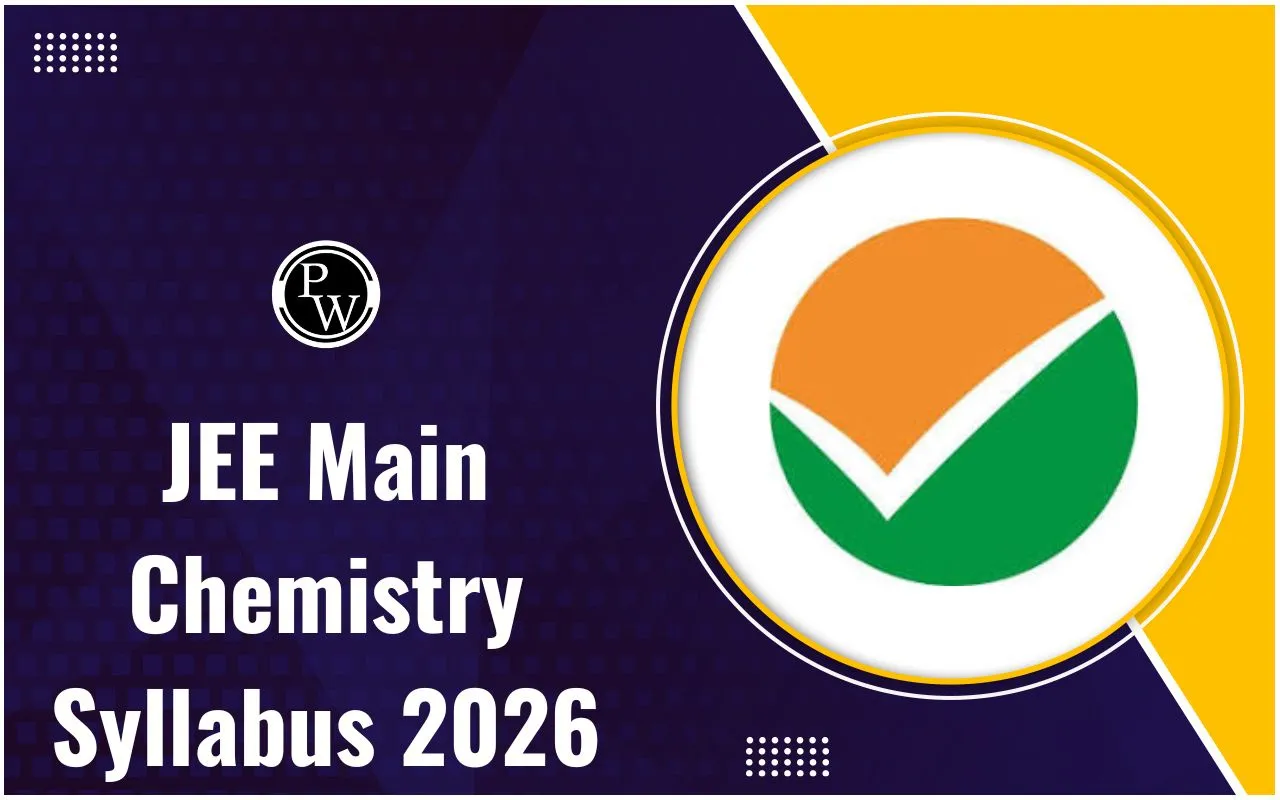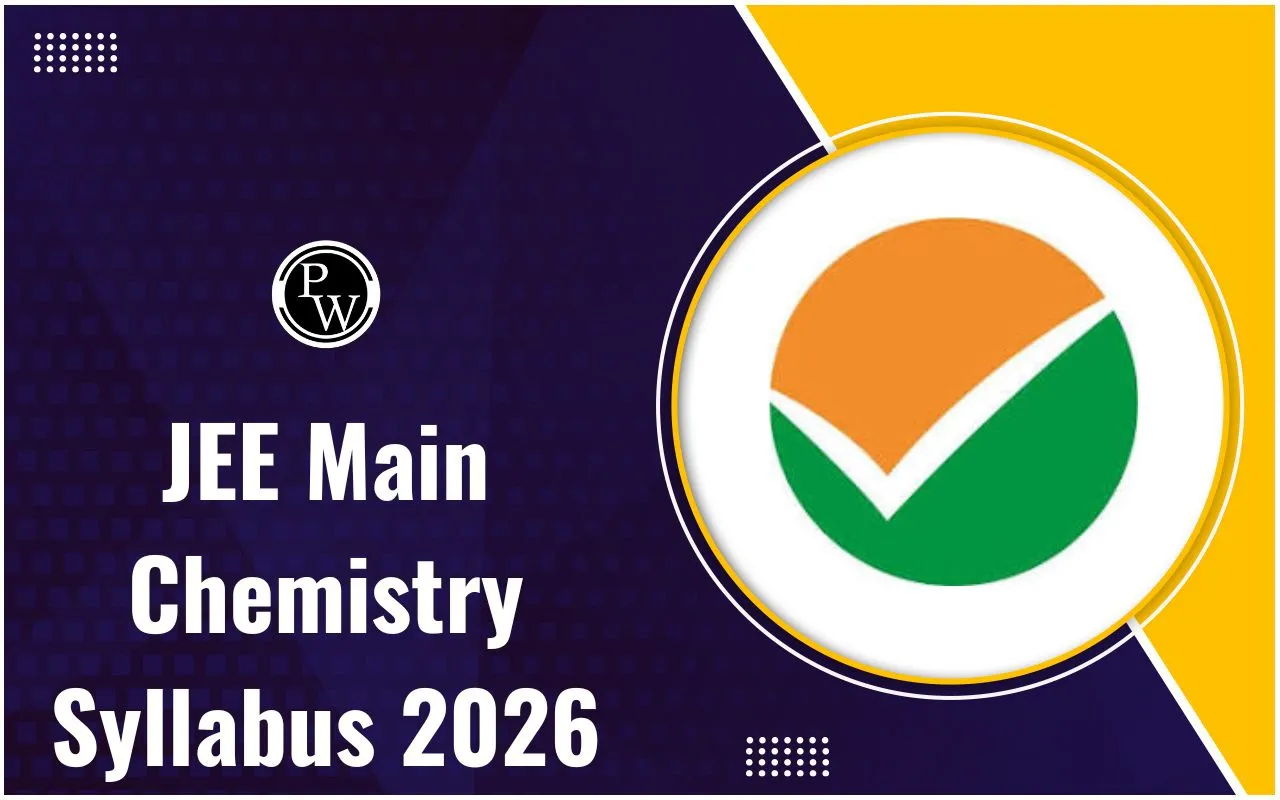

JEE Main Chemistry Syllabus 2026 is designed to test students understanding of fundamental concepts, problem-solving skills and analytical thinking in Chemistry. It covers three major branches: Physical Chemistry, Inorganic Chemistry and Organic Chemistry along with practical-based topics.
The syllabus emphasizes both theoretical knowledge and its application in numerical and experimental problems ensuring students are well-prepared for competitive examinations. With a clear focus on essential concepts students can efficiently plan their preparation and prioritize topics for scoring high in the Chemistry section.
Overview of JEE Main Chemistry Syllabus 2026
JEE Chemistry Syllabus 2026 provides a structured outline of all topics aspirants need to cover in Physical, Inorganic, and Organic Chemistry. Based on Class 11 and 12 NCERT textbooks, the chemistry JEE mains syllabus is designed to test both theoretical understanding and practical application.
The physical chemistry portion includes chapters like atomic structure, chemical bonding, thermodynamics, equilibrium, kinetics, and electrochemistry. Inorganic Chemistry focuses on periodic classification, p-block, d-block, f-block elements, and coordination compounds, while organic chemistry covers hydrocarbons, functional groups, biomolecules, and practical experiments.
The detailed JEE Main chemistry syllabus below breaks down each chapter with key topics, helping students plan their preparation effectively for the JEE mains 2026 syllabus.
Also Check:
Physical Chemistry Syllabus for JEE Main 2026
Physical Chemistry syllabus for JEE Main 2026 lays the foundation for understanding chemical concepts and developing problem-solving skills. It focuses on both theoretical knowledge and numerical applications, helping students excel in the Chemistry section.
The physical chemistry JEE mains syllabus includes 8 major chapters that are essential for scoring high in the exam. Aspirants can refer to this physical chemistry syllabus for JEE to plan their preparation effectively, understand core concepts and practice important numerical problems.
Physical Chemistry Topics for JEE Main 2026
The Physical Chemistry chapters for JEE Main 2026 cover all fundamental topics required for the exam. The chapters in the JEE physical chemistry syllabus include:
|
JEE Main Syllabus of Physical Chemistry |
||
|
Chapter No. |
Chapter Name |
Subtopics |
|
1 |
Some Basic Concepts in Chemistry |
Matter and its nature; Dalton’s atomic theory; Concept of atom, molecule, element, compound; Laws of chemical combination; Atomic & molecular masses; Mole concept, molar mass; Percentage composition; Empirical & molecular formulae; Chemical equations & stoichiometry |
|
2 |
Atomic Structure |
Nature of electromagnetic radiation; Photoelectric effect; Hydrogen atom spectrum; Bohr model: postulates, energy & radius relations, limitations; Dual nature of matter, de Broglie relationship; Heisenberg uncertainty principle; Quantum mechanical model of atom; Atomic orbitals (1s, 2s); Quantum numbers (principal, angular, magnetic, spin); Shapes of s, p, d orbitals; Electron filling rules: Aufbau, Pauli, Hund; Electronic configuration and stability of half/full-filled orbitals |
|
3 |
Chemical Bonding and Molecular Structure |
Kossel-Lewis approach: ionic & covalent bonds; Ionic bonding: formation, factors, lattice enthalpy; Covalent bonding: electronegativity, Fajan’s rule, dipole moment; VSEPR theory & molecular shapes; Valence Bond Theory: hybridization, resonance; Molecular Orbital Theory: LCAO, bonding & antibonding orbitals, sigma & pi bonds, bond order, bond length, bond energy; Metallic bonding & hydrogen bonding |
|
4 |
Chemical Thermodynamics |
Fundamentals: system, surroundings, extensive & intensive properties, state functions, entropy; First law of thermodynamics: work, heat, internal energy, enthalpy, heat capacity; Hess’s law & enthalpies: bond dissociation, combustion, formation, atomization, sublimation, phase transition, hydration, ionization, solution; Second law: spontaneity, ΔS, ΔG, ΔG°, equilibrium constant |
|
5 |
Solutions |
Concentration terms: molality, molarity, mole fraction, percentage (by volume & mass); Vapour pressure, Raoult’s Law (ideal & non-ideal); Colligative properties: relative lowering of vapour pressure, depression of freezing point, elevation of boiling point, osmotic pressure; Determination of molecular mass using colligative properties; Van’t Hoff factor and its significance |
|
6 |
Equilibrium |
Concept of dynamic equilibrium; Physical equilibria: solid-liquid, liquid-gas, gas-gas, solid-gas; Henry's Law; Chemical equilibrium: law of chemical equilibrium, equilibrium constants (Kp, Kc), ΔG & ΔG°, factors affecting equilibrium, Le Chatelier’s principle; Ionic equilibrium: weak & strong electrolytes, acid-base concepts (Arrhenius, Bronsted-Lowry, Lewis), ionization constants, pH scale, common ion effect, hydrolysis of salts, solubility products, buffer solutions |
|
7 |
Redox Reactions and Electrochemistry |
Concepts of oxidation & reduction, redox reactions, oxidation number, rules for assigning oxidation number, balancing redox reactions; Electrolytic & metallic conduction, conductance in solutions, molar conductivity, Kohlrausch’s law; Electrochemical cells: electrolytic & Galvanic cells, electrodes, electrode potential, emf, Nernst equation, relation of cell potential & Gibbs energy; Dry cells, lead accumulator, fuel cells |
|
8 |
Chemical Kinetics |
Rate of chemical reaction, factors affecting rate (concentration, temperature, pressure, catalyst); Elementary & complex reactions, order & molecularity; Rate law & rate constant; Differential & integral forms of zero & first-order reactions, half-life; Effect of temperature, Arrhenius theory, activation energy, collision theory (bimolecular gaseous reactions) |
Also Check: JEE Chemistry Questions
Inorganic Chemistry Syllabus for JEE Main 2026
Inorganic Chemistry syllabus for JEE Main 2026 focuses on the study of elements, their properties, reactions, and compounds.
This section of the JEE mains inorganic chemistry syllabus is designed to test aspirants’ conceptual understanding and memory-based problem-solving skills.
Covering both Class 11 and 12 NCERT topics, the inorganic chemistry JEE syllabus helps students build a strong foundation for the exam. Candidates can follow this inorganic chemistry syllabus for JEE mains to plan their preparation efficiently and focus on high-weightage chapters in the JEE mains inorganic syllabus 2026.
Inorganic Chemistry Topics for JEE Main 2026
The inorganic chemistry chapters for JEE Main 2026 cover essential topics from the periodic table and their applications.
The s block JEE mains syllabus includes alkali and alkaline earth metals, while the p block JEE mains syllabus focuses on Groups 13–18 elements. The d and f block JEE mains syllabus covers transition elements, lanthanoids, and actinoids.
Students also need to study metallurgy JEE mains syllabus (metal extraction and refining) and polymers in JEE mains syllabus (classification, preparation, and uses). This concise coverage helps aspirants focus on key inorganic chemistry topics for JEE Main 2026.
|
Inorganic Chemistry JEE Main Syllabus |
||
|
Section |
Chapter Name |
Subtopics |
|
Inorganic Chemistry |
Classification of Elements & Periodicity in Properties |
Modern periodic law, periodic table, s, p, d, f block elements, periodic trends: atomic & ionic radii, ionization enthalpy, electron gain enthalpy, valence, oxidation states, chemical reactivity |
|
p-Block Elements |
Groups 13–18: electronic configuration, trends in physical & chemical properties, unique behaviour of first element in each group |
|
|
d- & f-Block Elements |
Transition Elements: general introduction, electronic configuration, occurrence, properties (physical, ionization enthalpy, oxidation states, colour, magnetism, catalytic behaviour, complex formation, interstitial compounds, alloys), preparation, properties & uses of K₂Cr₂O₇ and KMnO₄; Inner Transition Elements: Lanthanoids (electronic configuration, oxidation states, lanthanoid contraction), Actinoids (electronic configuration, oxidation states) |
|
|
Coordination Compounds |
Introduction: Werner’s theory, ligands, coordination number, denticity, chelation, IUPAC nomenclature, isomerism; Bonding: Valence bond theory, basic Crystal Field Theory, colour & magnetic properties, importance in qualitative analysis, metal extraction, biological systems |
|
|
Organic Chemistry |
Purification & Characterisation of Organic Compounds |
Crystallization, sublimation, distillation, differential extraction, chromatography; Detection of N, S, P, halogens; Quantitative analysis (C, H, N, halogens, S, P); Calculation of empirical & molecular formulae |
|
Some Basic Principles of Organic Chemistry |
Tetravalency of carbon, hybridization, functional group classification, homologous series, isomerism (structural & stereoisomerism), nomenclature (trivial & IUPAC); Covalent bond fission, free radicals, carbocations, carbanions, electrophiles & nucleophiles; Electronic displacement: inductive, electromeric, resonance, hyperconjugation; Common reactions: substitution, addition, elimination, rearrangement |
|
|
Hydrocarbons |
Alkanes: conformations, halogenation; Alkenes: geometrical isomerism, electrophilic addition, polymerization; Alkynes: acidic character, addition & polymerization; Aromatics: benzene structure, aromaticity, electrophilic substitution, Friedel-Crafts alkylation & acylation, directive influence |
|
|
Organic Compounds Containing Halogens |
Preparation, properties, reactions, C–X bond nature, substitution mechanisms; Uses & environmental effects (chloroform, iodoform, freons, DDT) |
|
|
Organic Compounds Containing Oxygen |
Alcohols: identification, dehydration mechanism; Phenols: acidic nature, electrophilic substitution, Reimer-Tiemann reaction; Ethers: structure; Aldehydes & Ketones: nucleophilic addition, reactivity, reactions (Grignard, oxidation, reduction, Cannizzaro, Aldol, Haloform), chemical tests; Carboxylic acids: acidic strength & factors |
|
|
Organic Compounds Containing Nitrogen |
Amines: nomenclature, classification, identification, basic character; Diazonium salts: importance in synthetic organic chemistry |
|
|
Biomolecules |
Carbohydrates: classification, monosaccharides (glucose, fructose), oligosaccharides (sucrose, lactose, maltose); Proteins: amino acids, peptide bonds, polypeptides, protein structure (primary–quaternary), denaturation, enzymes; Vitamins: classification & functions; Nucleic acids: DNA & RNA constitution, functions; Hormones: general introduction |
|
|
Principles Related to Practical Chemistry |
Detection of extra elements (N, S, halogens) & functional groups (hydroxyl, carbonyl, carboxyl, amino); Preparation of inorganic compounds (Mohr’s salt, potash alum) & organic compounds (Acetanilide, p-nitroacetanilide, aniline yellow, iodoform); Titrimetric exercises: acids, bases, oxalic acid vs KMnO₄, Mohr’s salt vs KMnO₄; Qualitative salt analysis: cations (Pb²⁺, Cu²⁺, Al³⁺, Fe³⁺, Zn²⁺, Ni²⁺, Ca²⁺, Ba²⁺, Mg²⁺, NH₄⁺), anions (CO₃²⁻, S²⁻, SO₄²⁻, NO₃⁻, NO₂⁻, Cl⁻, Br⁻, I⁻); Experiments: enthalpy of CuSO₄ solution, enthalpy of neutralization, lyophilic/lyophobic sols, kinetic study of iodide & hydrogen peroxide reaction |
|
Also Check: JEE Main Chemistry Notes
Organic Chemistry Syllabus for JEE Main 2026
Organic Chemistry syllabus for JEE Main 2026 focuses on the study of carbon compounds, their structures, properties, reactions, and practical applications.
The JEE Mains organic chemistry syllabus is designed to test both conceptual understanding and problem-solving skills.
Students can refer to the organic chemistry syllabus JEE Mains to plan their preparation effectively, cover all high-weightage topics and strengthen their understanding of fundamental organic reactions. The JEE Main organic chemistry syllabus includes chapters from Class 11 and 12 NCERT textbooks ensuring complete coverage for the organic chemistry syllabus for JEE mains.
Organic Chemistry Topics for JEE Main 2026
The Organic Chemistry syllabus for JEE Main 2026 is divided into key chapters covering fundamental concepts, reactions and practical applications.
|
Organic Chemistry Topics for JEE Main 2026 |
|
|
Chapter |
Key Topics |
|
Alcohols, Phenols, and Ethers |
Preparation, properties, reactions, identification |
|
Carboxylic Acids and Their Derivatives |
Structure, acidity, reactions, important compounds |
|
Amines |
Classification, preparation, reactions, identification |
|
Aromatic Compounds |
Benzene, aromaticity, electrophilic substitution, derivatives |
|
Hydrocarbons |
Alkanes, alkenes, alkynes, reactions |
|
Biomolecules |
Carbohydrates, proteins, nucleic acids, vitamins |
|
Practical Organic Chemistry |
Qualitative and quantitative analysis, detection of functional groups, preparation of key compounds |
Also Check: JEE Main Previous Year Question Papers
Deleted and Reduced Topics in Chemistry for JEE Main 2026
NTA has revised the JEE Main Chemistry syllabus 2026, removing certain chapters and topics to streamline the exam focus. Aspirants must be aware of the deleted syllabus of JEE Mains 2026 and the reduced syllabus of JEE Mains 2026 to plan their preparation effectively.
Questions on topics like p-block elements or solid-state may no longer appear so students often ask, is p block removed from JEE 2026 or is solid state deleted in JEE Mains 2026?
The table below lists all topics removed from each chapter helping candidates focus on the updated JEE Mains 2026 deleted syllabus.
|
Deleted & Reduced Topics in Chemistry for JEE Main 2026 |
|
|
Chapter Name |
Deleted Topics |
|
Some Basic Concepts in Chemistry |
Physical quantities and their measurements, Precision and accuracy, Significant figures, S.I. Units, Dimensional analysis |
|
States of Matter |
Classification of matter (solid, liquid, gas); Gaseous state: Boyle’s law, Charles’s law, Graham’s law of diffusion, Avogadro’s law, Dalton’s law of partial pressure, Absolute scale of temperature, Ideal gas equation, Kinetic theory of gases (only postulates), Average, root mean square and most probable velocities, Real gases, compressibility factor, van der Waals equation; Liquid state: vapour pressure, viscosity, surface tension, effect of temperature (qualitative); Solid state: molecular, ionic, covalent, metallic solids, amorphous & crystalline solids, Bragg’s law, unit cell, lattices, packing (fcc, bcc, hcp), voids, unit cell calculations, imperfections, electrical & magnetic properties |
|
Atomic Structure |
Thomson and Rutherford atomic models and their limitations |
|
Surface Chemistry |
Adsorption (physisorption & chemisorption), Freundlich & Langmuir isotherms, adsorption from solutions; Catalysis (homogeneous & heterogeneous), enzyme catalysis & mechanism; Colloidal state: distinction among solutions, colloids, suspensions; classification: lyophilic, lyophobic, multi-molecular, macromolecular, associated colloids; Preparation & properties of colloids, Tyndall effect, Brownian movement, electrophoresis, dialysis, coagulation, flocculation, emulsions & characteristics |
|
General Principles & Processes of Isolation of Metals (Metallurgy) |
Modes of occurrence of elements, minerals, ores; Steps in extraction of metals (concentration, reduction, refining) with reference to Al, Cu, Zn, Fe; Thermodynamic & electrochemical principles in metal extraction |
|
Hydrogen |
Position in periodic table, isotopes, preparation, properties & uses; Physical & chemical properties of water & heavy water; Hydrogen peroxide: structure, preparation, reactions, uses; Hydrides: ionic, covalent, interstitial; Hydrogen as fuel |
|
S-Block Elements |
General introduction |
|
P-Block Elements |
Electronic configuration & trends; Anomalous properties of first element in each group; Important compounds (Na₂CO₃, NaOH, NaHCO₃); Industrial uses of lime, limestone, Plaster of Paris, cement; Biological significance of Na, K, Mg, Ca; Group-wise compounds: Boron & Al, borax, boric acid, diborane, BF₃, AlCl₃, alums; Group 14: catenation, allotropes & oxides of carbon, SiCl₄, silicates, zeolites, silicones; Group 15: N & P compounds, allotropic P, NH₃, HNO₃, PH₃, P halides; Group 16: Ozone, allotropic S, H₂SO₄; Group 17: HCl, acidic trend of hydrogen halides, interhalogen compounds, oxides & oxoacids; Group 18: Noble gases, fluorides & oxides of Xe |
|
Environmental Chemistry |
Atmospheric, water & soil pollution; Tropospheric pollutants: oxides of C, N, S; Hydrocarbons: sources, harmful effects & prevention; Greenhouse effect & global warming; Acid rain; Particulate pollutants: smoke, dust, smog, fumes, mist; Stratospheric pollution: ozone formation & breakdown, ozone depletion; Water pollution: pathogens, organic & chemical pollutants; Soil pollution: pesticides (insecticides, herbicides, fungicides); Pollution control strategies |
|
Polymers |
General introduction & classification; Polymerization methods: addition, condensation; Copolymerization, natural & synthetic, rubber & vulcanization; Important polymers: polythene, nylon, polyester, bakelite, with monomers & uses |
|
Chemistry in Everyday Life |
Chemicals in medicines: analgesics, tranquilizers, antiseptics, disinfectants, antimicrobials, anti-fertility drugs, antibiotics, antacids, antihistamines; Chemicals in food: preservatives, artificial sweetening agents; Cleansing agents: soaps & detergents, cleansing action |
JEE Main Chemistry 2026 PDF Download
JEE Main Chemistry Syllabus PDF provides a comprehensive outline of all topics from Physical, Inorganic and Organic Chemistry, including practical-based concepts. Students can use this syllabus to plan their preparation effectively and focus on important chapters for better performance. For convenience students can download the complete PDF of the JEE Main Chemistry Syllabus 2026 from the link below and keep it handy for quick revision and structured study.
JEE Main Chemistry Syllabus PDF
Chapter-wise Weightage in Chemistry for JEE Main 2026
The table below shows the approximate number of questions and weightage of each chapter in the Chemistry section of JEE Main. This analysis is based on previous years papers and helps aspirants focus on important topics for effective preparation.
|
Chapter-wise Weightage of Chemistry in JEE Main 2026 |
||
|
Chapter |
Total Questions |
Weightage |
|
Mole Concept |
1 |
3.3% |
|
Redox Reactions |
1 |
3.3% |
|
Electrochemistry |
1 |
3.3% |
|
Chemical Kinetics |
1 |
3.3% |
|
Solution & Colligative Properties |
1 |
3.3% |
|
General Organic Chemistry |
1 |
3.3% |
|
Stereochemistry |
1 |
3.3% |
|
Hydrocarbon |
1 |
3.3% |
|
Alkyl Halides |
1 |
3.3% |
|
Carboxylic Acids & Their Derivatives |
1 |
3.3% |
|
Carbohydrates, Amino Acids & Polymers |
1 |
3.3% |
|
Aromatic Compounds |
1 |
3.3% |
|
Atomic Structure |
2 |
6.6% |
|
Chemical Bonding |
2 |
6.6% |
|
Chemical & Ionic Equilibrium |
2 |
6.6% |
|
Solid-State & Surface Chemistry |
2 |
6.6% |
|
Nuclear & Environmental Chemistry |
2 |
6.6% |
|
Thermodynamics & Gaseous State |
2 |
6.6% |
|
Transition Elements & Coordination Compounds |
3 |
9.9% |
|
Periodic Table |
3 |
9.9% |
Also Check: JEE Main Chemistry Chapter-Wise Weightage 2026
JEE Main Chemistry Preparation Tips 2026
Preparing Chemistry for JEE Main 2026 requires a strategic approach, as the syllabus is vast and includes Physical, Inorganic and Organic Chemistry. Here is a detailed guide on how to cover it effectively.
1. Strategy for Different Sections
-
Physical Chemistry: Focus on understanding concepts and derivations rather than rote learning. Prioritize chapters like Thermodynamics, Solutions, Equilibrium and Chemical Kinetics. Solve numerical problems daily and practice previous years questions to strengthen problem-solving speed.
-
Organic Chemistry: Emphasize reaction mechanisms, functional groups, and named reactions. Learn reactions of important compounds and make summary sheets for quick revision. Focus on high-yield topics like Hydrocarbons, Alcohols, Aldehydes & Ketones, Carboxylic Acids and Amines.
-
Inorganic Chemistry: Concentrate on Periodic Table, p-block, d-block, and coordination compounds. Inorganic requires memorization with understanding, so use charts, flashcards and tables to retain facts, oxidation states, and trends.
2. Time Management Tips
-
Divide your preparation: Allocate 40% time to Physical, 30% to Organic and 30% to Inorganic Chemistry based on difficulty and familiarity.
-
Daily Practice: Dedicate at least 1–2 hours for numerical problems and another 1 hour for theory revision.
-
Regular Revision: Revise inorganic and organic topics weekly as these need constant recall. Physical Chemistry can be revised after every numerical practice session.
-
Mock Tests & Previous Papers: Solve previous 5–10 years questions and full-length mock tests to identify weak areas and improve speed.
3. Suggested Study Sequence
-
Physical Chemistry First: Start with basics and numerical-heavy chapters to build strong problem-solving skills.
-
Inorganic Chemistry Next: Focus on memorization-friendly topics using charts and flashcards.
-
Organic Chemistry Last: End with Organic Chemistry, revising mechanisms, reactions and practical applications.
-
Revision Cycle: Allocate the last month for mixed revision covering all three branches and solving mock tests regularly.
Also Check: How to Prepare for JEE Main 2026
Study Materials For JEE Main Chemistry
Candidates can check the study materials below prepared by the faculty of Physics Wallah for the JEE Main Chemistry subject.
JEE Main Chemistry Syllabus 2026 FAQs
What is the complete syllabus of Chemistry for JEE Main 2026?
Has the syllabus changed from last year?
Which topics are deleted or reduced in Chemistry for JEE Main 2026?
Is P Block removed from JEE Main Chemistry 2026?













